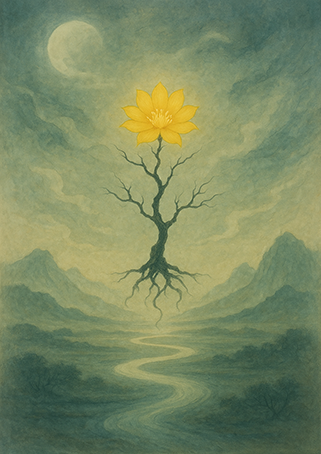Xieyi・The Rootless Tree:100 Verses-Verse 44#440

The poems of “The Rootless Tree” express a fundamental force rooted in harmony with heaven and earth, the cyclical flow of yin and yang, and the infinite potential of existence。
This painting is an expressive “Xieyi” in the tradition of “futu” (spiritual diagrams), passed down for generations in Wudang Mountain, China. It is drawn through a technique where energy flow (xingqi) channels the internal intention into visual form。 In the Taoist world, there exist spiritual and symbolic images called “futu”。
In the Taoist world, there exist spiritual and symbolic images called “futu”。
These are a type of talisman—not merely religious items, but expressive spiritual paintings that act directly on the mind of the viewer。
Since ancient times, many people have placed these Taoist-style “Xieyi” and futu in their homes, studies, or bedrooms, wishing for longevity, health, auspiciousness, and family harmony. Viewing such paintings was not just aesthetic appreciation, but an act of inviting the presence of the Dao into one’s life and tuning the body and mind。
Thus, “Xieyi” is more than artistic expression—it is a medium that bridges the spirit, life, and harmony with the universe。
This kind of artwork is not meant to be seen only with the eyes, but felt with the heart。
It communicates with the Dao, resonates with the qi of nature, and quietly stirs the viewer’s inner self。
Futu and “Xieyi” continue to live on from ancient times to this day as “sacred images that speak to the soul.”
Below, we present the original text of the philosophical poem “The Rootless Tree,” along with a modern Japanese translation and interpretation。
※ The author of “The Rootless Tree,” Zhang Sanfeng (1247–?), is also renowned as the founder of Tai Chi, and it is said that he applied the essence of this work to Tai Chi. As an additional note, we include an interpretation connecting this to the Tai Chi tradition of Wudang Mountain.
The Rootless Tree・Verse 44

▶Original Text
無根樹,花正黃,行止有常,心隨氣定。陰陽相順,氣運無窮,行者無求,心無所著。
▶Modern Translation
A yellow flower crowns the rootless tree;
In motion or stillness it stays with principle, heart settled in qi.
Yin and yang obey one another, qi circulates without end;
The traveller seeks nothing and holds to nothing.
▶Interpretation
1.[無根樹,花正黃] Yellow = central balance.
2.[行止有常,心隨氣定] Acting or pausing by law, heart firm with qi.
3.[陰陽相順,氣運無窮] Endless flow through compliant polarity.
4.[行者無求,心無所著] No grasping = ultimate freedom.
▶Interpretation related to Tai Chi
•“Central equilibrium” in every shift.
•Continuity of force—no breaks.
•Detachment unlocks spontaneous technique.
Copyright © MASAKI WAKABAYASHI. All rights reserved.




